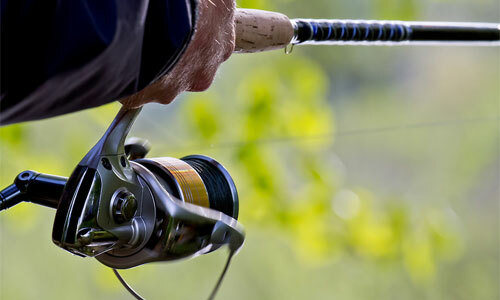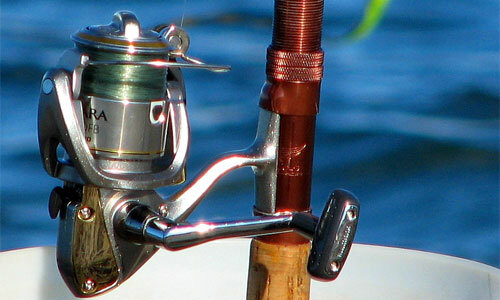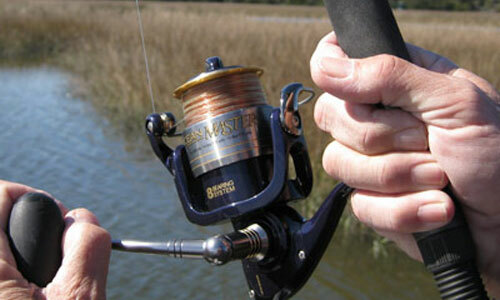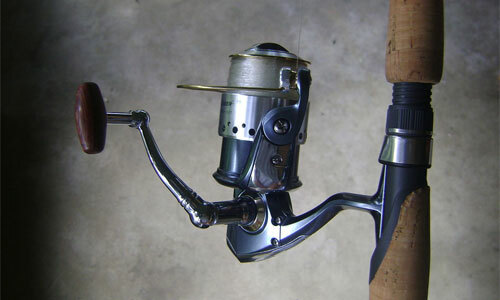The word "fishing" causes many men to have pleasant associations. After all, each of them wants to feel like an earner, having experienced the excitement and joy of victory. Most of all, these sensations when fishing for spinning, when you go to a duel with a large fish, artfully vyvazhivaya it.

At the same time quietly releasing the line with the help of a coil, an experienced fisherman gives the opportunity to extract a little bit to relax, and then cuts it and pulls it out. Those who begin to learn the wisdom of fishing, often wondering how to choose a spool for spinning. Let's talk about this in order.
First of all, you should know that the coils for spinning can be inertial type, inertia-free and multiplier. The first type is characterized by the fact that when the line is cast, the rotation of the coil does not stop even when the bait has reached the specified point. And the inertial coil, on the contrary, stops after casting.
For beginners, you can advise exactly this kind of coils. As for the multiplier coils, they are not used often, for very large fish and long casts.
When choosing an inertia-free coil, you need to pay attention to the following things:
Class - determines the size of the device, the volume of the line being loaded and the permissible loads. The most popular designations of classes adopted by Japanese manufacturers are Daiwa and Shimano - classes from 1000 to 4500. The latter is the heaviest, used for powerful spinning. The transmission ratio, recorded as a proportion, determines how many revolutions the rotor will travel around the bobbin at one turn of the handle.

If this ratio is less than 5: 1, then the fishermen call the coil a power, or traction. If more, then the coil is called high-speed. The high-speed device serves for fishing with a twister, a maneuverable fish, and a power device for fighting large prey.
The basic elements of the
coil Each spinning coil consists of the following parts:
- Body
- Roller for the scraper( from silicon carbide or titanium nitride)
- Handle
- Foot
- Rotor
- An arch that can be hollow or monolithic.
- Spool( metal or carboplast)
- Nut for frictional braking.
Separately, it should be said about the bearings. Watching on television an enticing advertisement, praising new fishing reels with a number of bearings of eight, or even ten, it is not necessary to be too flattered. After all, even for the most powerful power coil five bearings is enough. The main thing is that they should be of proper quality.
Where you can not do without a bearing, so it's in the video. And its course should be smooth, otherwise the line will become unevenly wound up, you can get a "beard", which later will have to be tediously and tediously unraveled. It is very convenient when the bearings in the roller, handle and spool are the same - if necessary, you can replace one with another. Yes, and more: closed and better bearings are better and more reliable.
Line laying mechanism - which to choose
Many "advanced" fishermen with experience confidently declare that if the spinning coils do not have an infinite mechanism, or Archimedes, a screw, then one should not even look at such models. This settled opinion, however, refuted the new developments of Daiwa and Shimano, which use the good old crank-and-rod mechanism, and the line is wound up perfectly.

In this case, in particular, either an S-shaped groove or square and elliptical gears( as in the Shimano Sedona model) are used, allowing the spool to move at a variable speed. By the way, when talking about gears, it should be mentioned that stronger than those made of yellow metal, and not from white. It's easy to see by taking off the spool. Under the nut, you can see the edge of the gear.
Who are we going to catch, what and where?
The choice of the fishing reel primarily depends, of course, on which water body and what gear it is to fish. After all, for different fish, there are different ways of catching: trout, for example, quickly slides over the water surface, and the heavy cat moves closer to the bottom, slowly and carefully. Accordingly, and catch them with different gear.
And the reel is bought to match the spinning. So, for example, if it's light, it's completely ridiculous to buy a heavy power coil. And vice versa. For rods with a length of 2.7 to 3.5 meters, coils of class 2500, for example, are quite suitable. If the length of the fishing rod is less than 2.7 meters, it is reasonable to buy a spinning coil with a light spoon, with a spool volume of 1000 or 1500, not more.

If to talk more about this moment, then:
Class 500 - reels weighing not more than 170 grams are used for spinning type ultralight. Classes 1000-1500 - such coils can be used for both ultralight and light spinning. Class 2000 - medium variant, more universal. Classes 3000-4000 - powerful coils, well suited for feeder and thick spinning. Class 4500 - suitable for catching very large fish.
What to look for when buying
When you come to the store for a long-awaited coil, first of all ask the seller a technical passport of the model chosen. On it you will see the mechanism of the device in a section and you will be able to understand whether there are any shortcomings. Take the reel in hand and twist it. To properly select the coil, keep in mind that:
- The device must have a smooth running. Too much crackling and jamming should alert.
- Several times having thrown and having put in place the bow, make sure that the fishing line immediately falls exactly on the roller.
- Check the attachment of the handle: if the thread to which it is attached is too small, it is possible to tear it off while twisting.
- Bearings( in good coils of them from four to six) should be located in a roller, a forest laying, on a gear wheel of a rotor and in the handle.
- The friction brake must be adjustable.
- Handle - is better replaceable, with the ability to install both under the left and under the right arm.
- The gear must not be made of plastic and aluminum - this will not last long. It's better if it's brass or bronze. As mentioned before, you can remove the spool and look under the nut, what color is the visible edge of the gear. If it is yellow, everything is fine. White is worse. Excellent, if the kit contains a spare spool - you can wind it with a line of another thickness or replace it with a breakage.
Let's talk about the brands
Determining with which one to choose the spinning coil, many of them primarily come from their financial capabilities. But this does not mean that someone wants to buy a cheap device that can last a very short time. Therefore, we will not consider models from the "market" from wretched plastic. If we talk about the price of coils, then it can reach $ 1,000.Not every novice will dare to dump such a sum for a spinning reel. Therefore it is quite reasonable in this case to stop at a price of 2-5 thousand rubles.
The best in the market of coils are 2 "Japanese": Shimano( profile - high-speed coils) and Daiwa( leader in traction coils).And each of these firms has both very expensive and budget models. They serve the masters for many years without causing censure. Good models from the Swedish company Abu Garsia, French - Mitchel, Polish - MIKADO, FLAMINGO, German - DAM, Korean - WONDER, BANAX, Chinese - OKUMA, KOBRA.
Therefore, when choosing a coil, choose a reliable manufacturer and strong materials.



